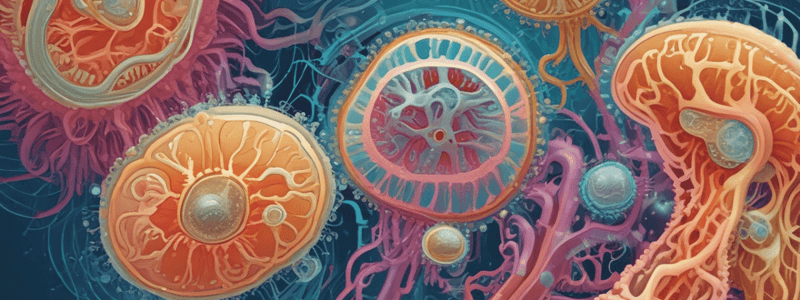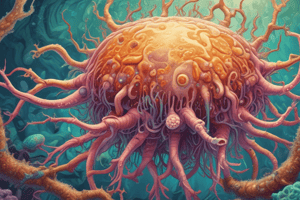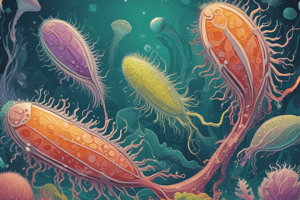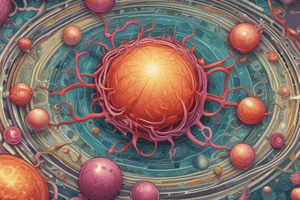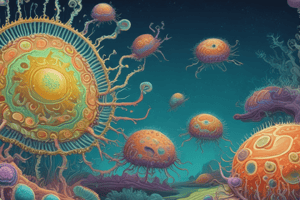Podcast
Questions and Answers
Dinoflagellates have two ______ and each cell is reinforced by cellulose plates
Dinoflagellates have two ______ and each cell is reinforced by cellulose plates
flagella
The ______ include Dinoflagellates, Apicomplexans, and Ciliates
The ______ include Dinoflagellates, Apicomplexans, and Ciliates
alveolates
Euglenozoa is a diverse clade that includes ______ and kinetoplastids
Euglenozoa is a diverse clade that includes ______ and kinetoplastids
euglenids
The main feature distinguishing Euglenozoa as a clade is a spiral or crystalline rod of unknown function inside their ______
The main feature distinguishing Euglenozoa as a clade is a spiral or crystalline rod of unknown function inside their ______
Kinetoplastids have a single ______ with an organized mass of DNA called a kinetoplast
Kinetoplastids have a single ______ with an organized mass of DNA called a kinetoplast
The supergroup ______ is monophyletic and originated by a secondary endosymbiosis event
The supergroup ______ is monophyletic and originated by a secondary endosymbiosis event
The proposed endosymbiont of the supergroup SAR is a ______ alga
The proposed endosymbiont of the supergroup SAR is a ______ alga
Members of the sub-group ______ have membrane-bounded sacs (alveoli) just under the plasma membrane
Members of the sub-group ______ have membrane-bounded sacs (alveoli) just under the plasma membrane
The informal name of the group of mostly unicellular eukaryotes that are not fungi, plants or animals is ______.
The informal name of the group of mostly unicellular eukaryotes that are not fungi, plants or animals is ______.
Marine protists, called ______, have tests fused into one delicate piece, usually made of silica.
Marine protists, called ______, have tests fused into one delicate piece, usually made of silica.
Most ______ are unicellular, but there are some colonial and multicellular species.
Most ______ are unicellular, but there are some colonial and multicellular species.
Mixotrophs combine ______ and heterotrophic nutrition.
Mixotrophs combine ______ and heterotrophic nutrition.
Foraminiferans, or ______, are named for porous, generally multichambered shells, called tests.
Foraminiferans, or ______, are named for porous, generally multichambered shells, called tests.
Some protists reproduce asexually, while others reproduce ______, or by the sexual processes of meiosis and fertilization.
Some protists reproduce asexually, while others reproduce ______, or by the sexual processes of meiosis and fertilization.
______ is the supergroup that includes red algae, green algae, and land plants.
______ is the supergroup that includes red algae, green algae, and land plants.
The supergroup that includes Dinoflagellates and Apicomplexa is called ______.
The supergroup that includes Dinoflagellates and Apicomplexa is called ______.
Red algae are reddish in color due to an accessory pigment called ______, which masks the green of chlorophyll.
Red algae are reddish in color due to an accessory pigment called ______, which masks the green of chlorophyll.
Green algae are named for their ______ chloroplasts.
Green algae are named for their ______ chloroplasts.
The supergroup that includes Euglenozoa is called ______.
The supergroup that includes Euglenozoa is called ______.
The supergroup that includes Stramenopila, Alveolata, and Rhizaria is called ______.
The supergroup that includes Stramenopila, Alveolata, and Rhizaria is called ______.
The supergroup ______ includes animals, fungi, and some protists.
The supergroup ______ includes animals, fungi, and some protists.
Slime molds, or ______, were once thought to be fungi.
Slime molds, or ______, were once thought to be fungi.
Protists, the most ______ diverse of all eukaryotes, include photoautotrophs, heterotrophs, and mixotrophs.
Protists, the most ______ diverse of all eukaryotes, include photoautotrophs, heterotrophs, and mixotrophs.
Many ______ have endosymbiotic algae.
Many ______ have endosymbiotic algae.
Flashcards are hidden until you start studying
Study Notes
Euglenozoa
- A diverse clade that includes euglenids and kinetoplastids
- Members can be predatory heterotrophs, photosynthetic autotrophs, or parasites
- Characterized by a spiral or crystalline rod of unknown function inside their flagella
- Euglenids have one or two flagella that emerge from a pocket at one end of the cell
- Kinetoplastids have a single mitochondrion with an organized mass of DNA called a kinetoplast
Kinetoplastids
- Include free-living consumers of prokaryotes in freshwater, marine, and moist terrestrial ecosystems
- Examples: Trypanosoma gambiense (causes sleeping sickness in humans) and another pathogenic trypanosome that causes Chagas’ disease leading to congestive heart failure
SAR (Supergroup)
- Proposed to have originated by a secondary endosymbiosis event involving a red alga
- A controversial clade that includes alveolates and stramenopiles
Alveolata (Sub-group)
- Characterized by membrane-bounded sacs (alveoli) just under the plasma membrane
- Function of alveoli is unknown
- Includes dinoflagellates, apicomplexans, and ciliates
Dinoflagellates
- Have two flagella and each cell is reinforced by cellulose plates
- Abundant components of both marine and freshwater phytoplankton
- A diverse group of aquatic phototrophs, mixotrophs, and heterotrophs
- Can cause toxic "red tides" through blooms
Protists
- The informal name for a group of mostly unicellular eukaryotes that are not fungi, plants, or animals
- A polyphyletic group, with Protista no longer valid as a kingdom
- Can be unicellular, colonial, or multicellular
- Nutritionally diverse, including photoautotrophs, heterotrophs, and mixotrophs
- Can reproduce asexually, sexually, or by alternation of generations
Archaeplastida (Supergroup)
- Includes red algae, green algae, and land plants
- Characterized by the presence of chloroplasts
Rhodophyta (Red Algae)
- Reddish in color due to the accessory pigment phycoerythrin
- Multicellular; the largest are seaweeds
- Most abundant large algae in coastal waters of the tropics
Green Algae
- Named for their grass-green chloroplasts
- Plants are descended from green algae
- A paraphyletic group, with two main groups: chlorophytes and charophytes
- Chlorophytes live in freshwater, although many are marine
- Charophytes are the most closely related to land plants
Unikonta (Supergroup)
- Includes animals, fungi, and some protists
- Characterized by the presence of amoebozoans and opisthokonts (animals, fungi, and related protists)
- The root of the eukaryotic tree remains controversial
Studying That Suits You
Use AI to generate personalized quizzes and flashcards to suit your learning preferences.
